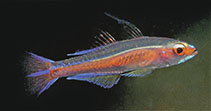| Family: |
Gobiidae (Gobies), subfamily: Gobiinae |
| Max. size: |
2 cm SL (male/unsexed); 1.96 cm SL (female) |
| Environment: |
reef-associated; marine; depth range 9 - 26 m |
| Distribution: |
Western Pacific: Japan, New Guinea and Palau. |
| Diagnosis: |
Dorsal spines (total): 7-7; Dorsal soft rays (total): 8-8; Anal spines: 1-1; Anal soft rays: 8-8. Diagnosis: Predorsal scales and a bony interorbital about pupil diameter in width. Second dorsal spine elongated. Fifth pelvic fin ray branched dichotomously once and 55-80% of the fourth. Scales on cheek absent; one or two cycloid scales on the upper opercle; usually two rows of scales anterior to the pelvic fin base. Snout and lower half of the caudal peduncle with a slight sprinkling of melanophores. A broad, rounded, median ridge present on the snout and anterior interorbital region. Unique to the genus, a large, bilateral, open nasal pit, instead of the usual nasal sac with anterior and posterior openings (Ref. 55345); characterized further by semi-translucent pinkish, abdomen and most of head reddish pink, merging with tapered pink stripe to middle caudal fin base; midline of snout with blue-white spot; internal white stripe above vertebral column; longitudinal scale series 23-25; predorsal scales 6-8 (Ref. 90102). |
| Biology: |
Collected from a quiet, sheltered bay (Ref. 55345). Inhabits sheltered bays in 9-26 m (Ref. 90102). |
| IUCN Red List Status: |
Least Concern (LC); Date assessed: 07 September 2021 Ref. (130435)
|
| Threat to humans: |
harmless |
Source and more info: www.fishbase.org. For personal, classroom, and other internal use only. Not for publication.

